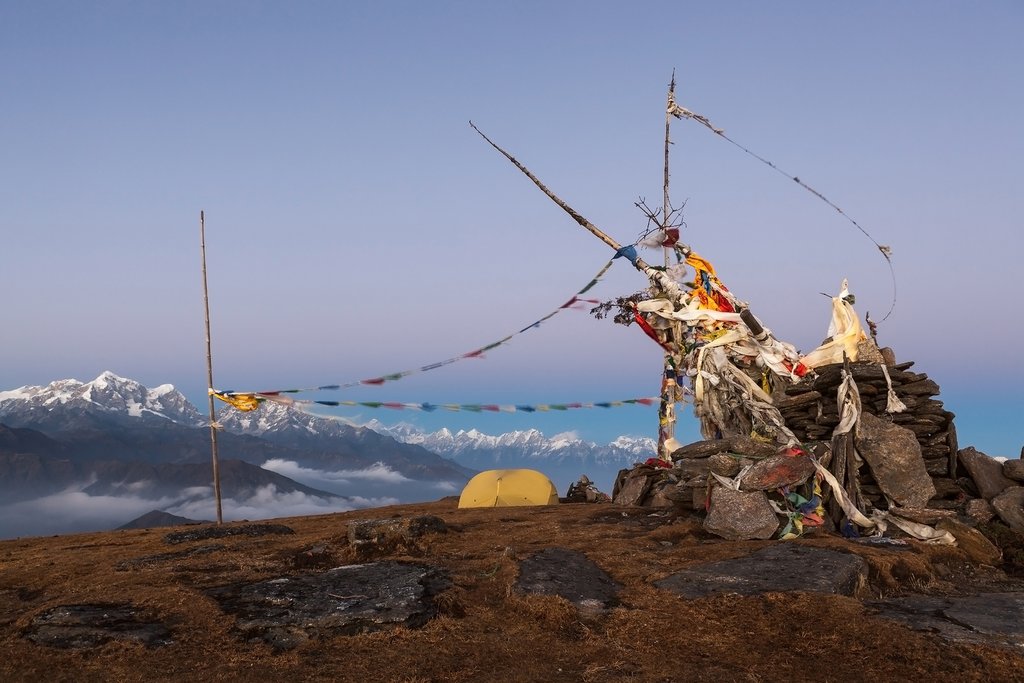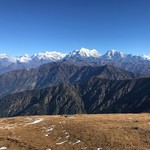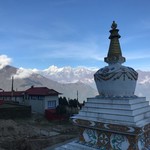Highlights
- Ascend Pikey Peak, one of the best viewpoints in Nepal
- Gain stunning views from Mt. Kanchenjunga to the Annapurnas
- Visit ‘Dudh Kunda’ lake, sacred to both Buddhist and Hindu religions
- Combine wilderness camping with nights in local tea houses
- Experience true Sherpa hospitality in authentic villages en route
- Learn about Himalayan Buddhism at the Thubten Choling and Chiwong monasteries
Overview
This 13-day trek gets you off the beaten track to explore lesser known villages and the wilder places of the lower Everest region. You combine nights spent in local tea houses at the lower altitudes with a wilderness camping component as you go well off the beaten path to visit the sacred ‘Dudh Kunda’ lake.
Your route takes you through authentic Sherpa villages where you stay with your local hosts, through stunning forests with a great chance of spotting wildlife and up into the awe inspiring Himalayan landscape around the sacred lake.
Your trek beings with a short flight to Phaplu from where you ascent to Pikey Peak, possibly the best viewpoint for the Himalayas in all of Nepal. On a clear day, you can see from Mt. Kanchenjunga in the east to the Annapurnas in the west! And of course, this includes Mt Everest, front and center.
From Pikey Peak, you trek down to the large Sherpa village of Junbesi and can visit the Thubten Choling Monastery, which is a first contact point for many Tibetan refugees and remains home to a large population of Tibetan Buddhists. You continue upwards to Dudh Kunda on the camping component of your trek and return to Phaplu via Chiwong Gompa (monastery).
Brief itinerary
| Day | Highlights | Altitude |
|---|---|---|
| Day 1 | Welcome to Kathmandu! | |
| Day 2 | Explore Kathmandu | |
| Day 3 | Fly to Phaplu, Drive to Dhap, Trek to Japre | 2,920 m |
| Day 4 | Trek to Pike Base Camp | 3,640 m |
| Day 5 | Trek to Pikey Peak and down to Taktor | 3,007 m |
| Day 6 | Trek to Junbesi and explore the monasteries and town | 2,700 m |
| Day 7 | Visit Thubten Choling monastery, camping | 3,250 m |
| Day 8 | Trek to Yak Kharka or nearest, camping | 3,840 m |
| Day 9 | Trek to Saharsbeni, camping | 4,037 m |
| Day 10 | Trek to Dudh Kunda, camping | 4,593 m |
| Day 11 | At Dudh Kunda, camping | 4,593 m |
| Day 12 | Trek to Timba or nearest, camping | 3,925 m |
| Day 13 | Trek to Taksindu | 2,842 m |
| Day 14 | Trek to Phaplu, optional visit to Chiwong Gompa | 2,413 m |
| Day 15 | Fly to Kathmandu; Depart |
Chat with a local specialist who can help organize your trip.
Detailed itinerary
Day 1: Welcome to Kathmandu!

As you fly into Kathmandu, you'll have beautiful views over the valley, the Himalaya, and of the terraced fields below. After going through customs, a representative will be waiting to guide you through the initial culture shock of Kathmandu’s narrow, winding streets and get you settled into your hotel. Once you've settled in, head out and visit one of Kathmandu's cultural highlights. In the evening, the tourist hub of Thamel is a good place to grab your first meal, with a variety of restaurants to chose from offering both Western and local Nepali dishes.
Day 2: Explore Kathmandu

Kathmandu has a special atmosphere during the early morning hours when the city is slowly coming to life yet not too chaotic. It's a great time to walk and explore the streets or have a chai overlooking one of the local courtyards or durbar squares. There are a number of ways you can spend the day given the many incredible sights around the Kathmandu Valley. Later in the evening, head out for dinner at one of the city's great eateries, or your specialist can arrange a home-cooked dinner with a local family.
Day 3: Fly to Phaplu, drive to Dhap, trek to Japre

After your short flight to the little airstrip at Phaplu, you can take a jeep and drive towards the ridgeline to the south at Dhap where you start your trek. As you near Sigane you can see mountains coming into view which you will get to know very well on this trek. These are the peaks of the Numbur Himal section of the Himalayan Range.
The trail from Sigane follows a road that is currently under construction for the first couple of hours. The first village is called Japre (2920m) and it is perched above a deep valley with lovely views of Everest and Numbur Himal. There’s a pretty little Gompa and Stupa here and you stay at a local tea house in the village.
Day 4: Trek to Pikey Base Camp
From Japre, the trail climbs up to a grassy ridge at Bhulbhule. There’s one lodge with no name and great views of the Everest range from here. Soon after Bhulbhule, the trail splits and you take the right trail up towards Pikey Peak. Your trail passes some old yak herders houses and a long ‘Mani Stone’ wall before contouring around the hillside below Taklung Danda (ridge). You continue along a beautiful forested trail with many Rhododendrons and, as you leave the forest, it’s about 2 hours to Pikey Peak base camp.
There’s just one lodge here at 3,640 m, with some (draughty) rooms in a separate building, but you may be able to use the dining room to hang out in the warmth. It’s a short climb to the summit at 4,065 m but unless there’s an unusually clear evening it’s better to go to bed early and save the climb for sunrise.
Day 5: Trek to Pikey Peak and down to Taktor
The trail to the top of Pikey Peak starts from behind the lodge and follows a gradual slope to the summit, strewn with prayer flags. It’s important to start before dawn to reach the top for sunrise as the views from the top are breathtaking. If the weather is clear you will be rewarded with views stretching from Annapurna to Kanchenjunga, it is truly amazing!
From the top of Pikey, you trek north down a ridgeline to Jase Bhanjyang, where a good crew will have breakfast ready for you. Leaving Jase Bhanjyang you have a few options for your descent to Junbesi, we highly recommend the stunning “Shortcut trail” which leaves the ridge shortly after Jase and descends steeply through spectacular old growth forest to Taktor (at approximately 3,007 m).
Here you meet the Everest Base Camp trail coming from Jiri, this means the tea houses are a little more developed and it’s one of the few times you might meet a few other trekkers.
Day 6: Trek to Junbesi and explore the village
From Taktor it is a couple of hours on a lovely trail to Junbesi (2,675 m), a traditional Sherpa village considered a cradle of Sherpa culture and architecture. The Sherpas regard the Solu Khumbu as a ‘Beyul’ or sacred valley and there are many Buddhist monasteries. Here, in this remote part of Nepal bordering Tibet, Buddhism survives with a deep faith and resonance. Junbesi is a large village and has a number of comfortable tea houses to choose from.
Day 7: Visit Thubten Choling monastery and camp farther up the valley

This morning you follow the river once more, meandering through fields and flowers, towards a very special place, Thupten Choling, home to 800 monks living in tiny cottages dotting the hill behind the main Gompa. His Holiness the late Trulsik Rinpoche founded the monastery in the 1960’s after fleeing Tibet. Thupten Choling houses, feeds, and educates a large population, 80% of whom are Tibetan refugees. This is one of the first contact points for the many Tibetans who find their way into Nepal each year. Although most refugees continue on to India, about 40 nuns per year stay on and join the monastery.
From here you continue up the valley for another hour to your first campsite where you are joined by the full camping crew for the first time. You will now be camping each night until you reach Taksindu.
Day 8: Trek to Yak Kharka
As you will be ascending steadily in the next few days, it is important to pay attention to how you’re your body is acclimatising. Your visit to Pikey Peak earlier in the trek has helped considerably with your acclimatisation, however, do pay attention to any of the early signs of altitude sickness and make sure you drink plenty of water. Today takes you through a magical forest up towards a pass near where you will spend the night.
Day 9: Trek to Saharsbeni

Over the next two days, you follow a ridge bringing you ever closer to the snow-covered peaks of the Rowaling Himal. It is hard to imagine, but this lonely trail teems with pilgrims at festival time! You will most likely have the whole landscape to yourself and camp in meadows, surrounded by rock faces and yak grazing.
Day 10: Trek to Dudh Kunda
Dudh Kunda Lake (4560m), at the foot of Mt. Numbur and Karyalung Glacier, is believed to be the abode of Lord Shiva. The full moon in August sees pilgrims flock to the lake as Buddhist and Hindu devotees believe that taking a dip in the icy lake will absolve them of their sins. It only takes a couple hours walking from your last camp and you can spend the rest of the day at leisure in this incredibly stunning place.
Day 11: At Dudh Kunda
Today is a day to rest and/or explore this amazing place. This truly is the high point of your trek, so we recommend you take your time here to really soak up the beauty of this place.
Day 12: Trek to Timba
After a morning Kora (circumambulation of the lake) you retrace our steps to Thadarbug and rejoin the classic pilgrim route towards the Taksindu La. You follow the ridgeline south and camp in one of the herder's camps along this trail.
Day 13: Trek to Taksindu
This morning you continue down the ridgeline towards the main Jiri to Everest trail at Taksindu La, from where you again have great mountains views. A short descent takes you to the Taksindu Monastery and the village where you can stay in a local tea house.
Day 14: Trek to Phaplu, optional visit to Chiwong Gompa

Today you leave the main trekking route again and take a beautiful path down to Phaplu through the forest. You have the option to hike up to Chiwong Gompa, perched high on a cliff overlooking the valley. This monastery was founded in 1923 and has magnificent celebrations for the Mani Rimdu festival in autumn. You continue on down into Phaplu and celebrate the completion of a great trek in your cosy tea house in the village.
Day 15: Fly to Kathmandu

Today you bid farewell to the mountains and take the flight back into the Kathmandu Valley. Enjoy your last moments in Kathmandu with breakfast in a café, a city stroll, and/or souvenir shopping. A representative will meet you at your hotel and drive you to the airport for your return flight home. It's good to be at the airport at least two hours prior to departure.
Variations
If you have more time then you can trek across to and fly out of Lukla, which is the starting point for the busy Everest Base Camp trail (another fortnight if you have the time for it). You can also enter or exit via Jiri which was the start of the historic trek route before flights became an option.
If you have less time, then you can reduce the number of days by removing the rest/exploration day at Dudh Khunda. It is also possible to trek to Dudh Kunda without visiting Pikey Peak, though we do highly recommend that you don’t skip it!
Best season
This area receives heavy rainfall during monsoon so we do not recommend the monsoon period for this trek. The best times to trek are the extended Spring season (mid- February to May) or in the Autumn (October to mid-December). During winter it is bitterly cold, but the skies are generally blue and the views crystal clear. The Rhododendrons will flower in spring, generally around March and this is a consideration for your travel times as the forests are truly stunning in flower.
Getting there & away
A short flight from Kathmandu brings you to the tiny Phaplu airport. It is wise to keep some buffer days at the end of your trek in case bad weather delays your flights, a relatively common occurrence at Phaplu. It is also possible to drive in although this takes an extra day and is quite a rough drive towards the end. Buffer days can be well spent exploring the fascinating Kathmandu Valley, getting a well-earned massage and eating the amazing food Kathmandu has on offer.






